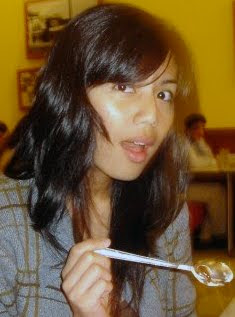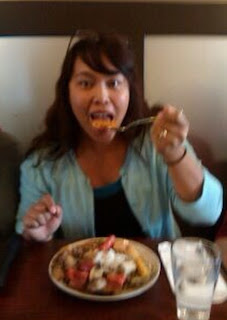When it comes to embarrassing childhood experiences, it's difficult to differentiate those that were typically embarrassing versus ones that were due to me just being a Fil-Am kid. Looking back, I was quite an eccentric child, but my strangeness felt punctuated at times by my traditional Filipino family.
In my family, we were raised to keep our personal lives very private. So I think this is part of the reason why I've struggled with responding to this blog topic for so long. But I think my mom would chuckle at the two incidences I'm going to share with you...I hope.
In the region my mother hails from, it's traditional to wear black for an entire year after your parents pass away. A whole year...ALL BLACK. While this could usually pass for a fashion statement, it doesn't fly all the time.
I'll never forget the year that my grandfather passed away. I was 14 and my brother was 12. My grandfather died in the Philippines, which left my mom and my aunt here in the U.S. without much family support for their grief. My brother and I didn't know Grandpa very well. We couldn't wrap our minds around the death of a family member, and were not much comfort for my mother and her sister. When they got back from the funeral, they purchased an entirely new wardrobe of all black clothes from Macys. EVERYTHING was black. Shoes, socks, shirts, pants, skirts, everything. My brother and I were not subject to this tradition, so though we thought it was a little weird, it didn't bother us...until we all went to Mass on Easter Sunday.
While everyone in Church was dressed in bright spring attire, pastel pinks and yellows to celebrate the Risen Lord, my mom and aunt were in ALL BLACK. It was like they had not gotten the memo that it was no longer Good Friday, or were showing up for a funeral. As we lined up for Holy Communion, I noticed the strange looks and whispers in the pews. I felt SO embarrassed. How was I going to explain to the entire congregation that we indeed were pleased that Jesus rose from the dead, it's just this old school Filipino tradition my mom and aunt insisted on practicing?
When Mass ended, my brother and I telepathically agreed to stay for a little bit, and let our mom and aunt get a head start walking over to the car. After about twenty, far away paces, we followed at a distance behind them...very slowly.
I became a problem child in high school. If I didn't see the point in going to class, and if I didn't like being there for any reason, I just wouldn't show up. I took advantage of my school's open campus policy, and walked over to the coffee shop (even McDonalds sometimes) to read what I wanted to read and smoke the cigarettes I managed to purchase illegally. Sometimes, I would meet up with friends from neighboring high schools, but most of the time, I enjoyed being on my own. I worked the system to avoid getting suspended, and intercepted warning notices from my family's home mailbox.
I thought I had it all under control until I got called out of class one day. I had orders to go directly to the vice-principals office. This particular vice-principal was actually a good looking white guy as far as high school administrators went, so it didn't really seem like punishment being sent there. Among my female classmates, he was known as the "handsome" VP. On my way to his office, I constructed my plan. Tell him I was sorry, that I've been helping a friend from another school get birth control or something, and work out a deal where I could serve detention under his supervision.
When I arrived at his office, I had the shock of my life. Mr. Handsome Vice Principal was sitting at his desk just as I had expected...but my mom was seated in the chair across from him. I wanted to disappear. I knew I was busted, big time. It was one thing to be in trouble with school administration. It was another thing to have crossed my mom. She was going to kill me. Mr. Handsome motioned that I come in and take a seat next to my mother.
I pulled out a chair, but avoided eye contact with her.
"So you know why you're here?" the vice-principal said.
I remained silent.
"Well, I thought it best to call your mother in..."
All of a sudden, I felt a tight grasp on my right ear and hair being pulled. In Tagalog, she called me a very, very bad word and asked what was wrong with me and why I was embarrassing her. At that moment, with my mother ready to do or say only God knows what else, I caught a glimpse of Mr. Handsome Vice Principal, frozen from shock, probably wondering what my mom just said to me, and whether or not he should call child protective services.
Finally, my mom let go, the vice principal regained his composure, and I heard my sentence. Not suspension, this time. But a couple of Saturday detentions, and a promise to start showing up to all my classes. I felt bad that I had gotten my mom that angry, and had given her cause to raise a hand at me, her supposedly nearly grown up daughter. Especially in front of my school principal, an
Americano.
Since Beverly shared a Russell Peters clip, I'm going to do the same. It's about Asian immigrant parents and corporal punishment. It's hilarious. Hope you enjoy:
http://www.youtube.com/watch?v=o4oO7ZdfSFI
 One of the earliest memories I have is walking up to the front of Nana's house, with the smell of home cooked ube halaya wafting through her screen door. Nana greets me at the door, spatula in hand, telling me to tikim or taste her fresh batch of ube made especially for me. Who would say no to that?!
One of the earliest memories I have is walking up to the front of Nana's house, with the smell of home cooked ube halaya wafting through her screen door. Nana greets me at the door, spatula in hand, telling me to tikim or taste her fresh batch of ube made especially for me. Who would say no to that?!













